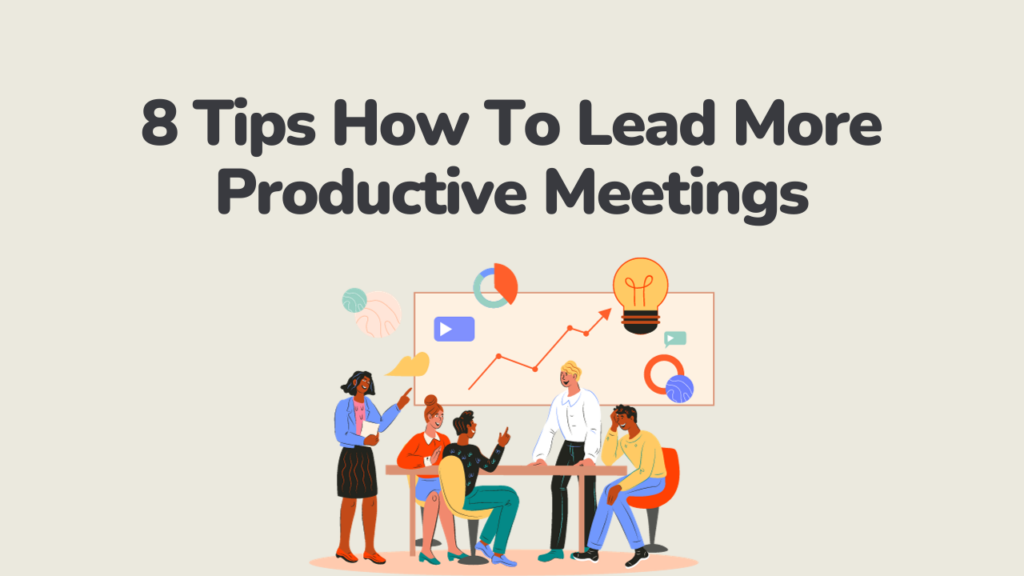Yes, You Can Lead More Productive Meetings: Here’s 8 Tips How

Table of Contents
For leaders and managers, conducting meetings comes with the territory, but that doesn’t mean that every meeting is productive or effective.
You may even be at the point where you dread announcing another meeting because it seems like some employees just don’t take them seriously.
Fortunately, there are better options than giving into discouragement or not scheduling the meetings your team needs to complete their projects to your satisfaction.
How to Make In-Person Meetings More Productive

The business world has adopted a hybrid model towards several functions, such as employees working both in the office and from home and a combination of in-person and remote meetings. Each type requires specific skills by the meeting organizer to ensure that the time away from productive work is most effective.
Start with a check-in before diving into the meeting agenda
Allowing employees to get into meeting mode by giving each person the opportunity to check in is an effective way to transition to a meeting.
The danger in not opening meetings this way is that people’s minds can still be on the task they were just working on or even issues in their personal lives.
A formal check-in encourages greater engagement because employees can state what they are thinking or struggling with along with their expectations for the time together.
Another benefit of announcing a check-in at the start of each meeting is that it allows participants to hear from their co-workers and empathize with their challenges.
To prevent employees from losing focus once the meeting formally starts, try to keep the time away from their desks to under one hour if possible.
Even people who start out engaged with the topics will have difficulty sustaining their attention for much longer than that.
Hand out written materials and reports ahead of time

Presenting the contents of a report in person instead of preparing, distributing, and asking people to read it before the meeting wastes a lot of time.
The same is true of any other documents, such as written correspondence from clients, that people could read in an email.
The more information you can distribute before scheduling a meeting, the less distracted people are and the more they can contribute to the discussion.
Call on people instead of waiting for them to speak up
Some people have brilliant ideas but introverted personalities, often preferring to defer to their more outgoing colleagues.
One of your responsibilities as a manager is to hear and consider feedback from everyone, not just those who score high on the extraversion scale.
Calling on employees, rather than having people jump in when they have something to say, is a great way to hear multiple perspectives.
If you have ever led or attended a chaotic meeting that seemed to have no order whatsoever, you should appreciate how this approach eliminates that problem entirely.
You may want to consider setting a timer before each person speaks as another safeguard against the same people dominating meetings each time.
Leading Effective Zoom Meetings
While in-person meetings offer the benefit of being able to read people’s body language, you may not see meeting participants at all when you conduct meetings over Zoom.
Although you can always request that each employee and other managers keep their camera on, viewing someone in a small square on a screen will never provide the non-verbal feedback that you can pick up when sitting across the table from them.
Avoid losing time to technical difficulties

No one wants to waste time while the meeting hosts try to figure out why not all participants can see and hear each other. You can avoid this problem by making sure you have installed Zoom correctly well before the meeting is scheduled to begin.
If you do run into problems with the microphone, speaker, or camera, you have time to troubleshoot the issue without feeling the pressure of having others waiting for you.
Make sure you’re in a quiet space and request that others are too
Not all loud sounds, such as an ambulance siren or a neighbor’s barking dog, are completely within a person’s control.
However, the meeting will be much more effective if people aren’t struggling to hear one another.
Ideally, you want to conduct remote meetings from a home office with a door you can keep shut.
Employees should arrange out-of-home care for their children during working hours, but especially during meetings.
Make sure everyone knows the ground rules about avoiding distractions and then reinforce the rules if necessary.
Try These Tips to Increase Employee Engagement during Meetings
You could be the most supportive manager in your entire company and still struggle with motivating your team to participate in meetings.
The members of your team are at especially high risk of going on autopilot if frequent meeting attendance is part of their job.
Your team depends on you to keep things as novel and interesting as possible.
Start the meeting on a positive note after everyone has checked in

The start of a meeting, before you dive into the formal agenda, is a perfect time to announce something positive.
Typical examples include an employee who has recently exceeded expectations, the company’s earning report increasing over the last quarter, or a team accomplishment.
The benefit of leading off with a positive report is that it sets the tone for the rest of the time together. People are often less likely to complain after hearing good news.
Change the location of meetings
Rather than meet in the same dull conference room each time, consider holding a meeting outside during pleasant weather, in the cafeteria when it’s not in use, or in an area of the building that is not frequently used.
You might be pleasantly surprised at what a big difference such a seemingly small change can make in employee attitudes and engagement.
Conclusion
Any of these steps can make your meetings more productive but don’t expect major changes overnight.
By regularly praising small improvements and encouraging empathetic listening, you’re likely to see a consistent pattern of more effective and enjoyable meetings.
